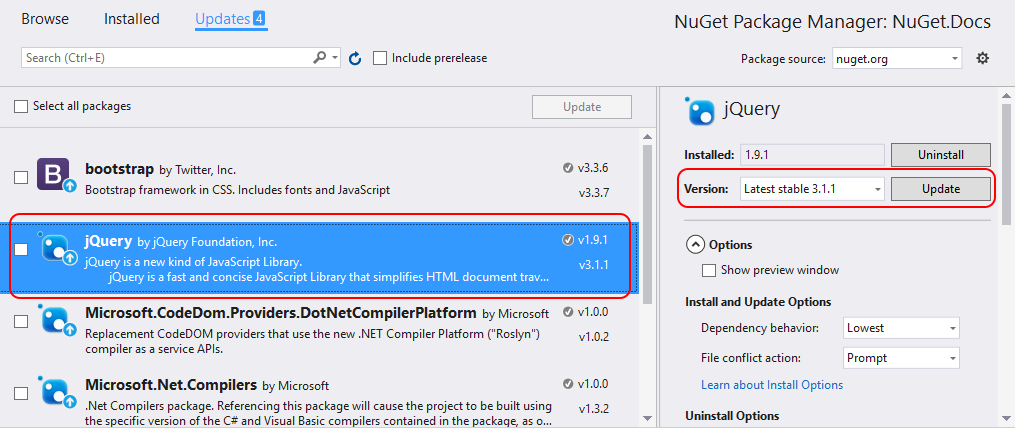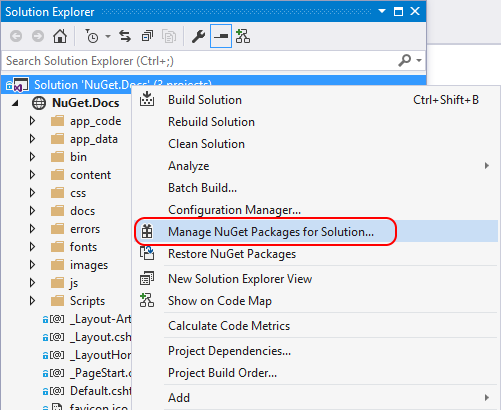

- #Visual studio package manager console commands install#
- #Visual studio package manager console commands update#

#Visual studio package manager console commands update#
Go to the command line and type nuget update -Source. Understanding Distributed Version Control Systems Open the Package Manager Console (select Tools > NuGet Package Manager > Package Manager Console).Understanding and Eliminating Technical Debt.Building Serverless Applications in Azure.Azure Container Instances: Getting Started.Microsoft Azure Developer: Implement Azure Functions (AZ-204).Versioning and Evolving Microservices in ASP.NET Core.Microservices Architecture: Executive Briefing.Open Visual Studio On the File menu point to New and then click Project. Microsoft Azure Developer: Deploying and Managing Containers approach via the Scaffold-DbContext command of Package Manager Console.Now I can run my Mercurial commands from within the Package Manager Console: PM> hg status Having done that, you need to reload Visual Studio, and after loading a solution, you can type solutionFolder to navigate to the solution folder: PM> solutionFolderĪnd that's it. Then, I added my snippet of script into a function: This file didn’t actually exist (nor did the WindowsPowerShell folder), so I had to create a blank one. The path to this is found in the $profile variable: PM> $profileĬ:\Users\Mark\Documents\WindowsPowerShell\NuPack_profile.ps1 This requires editing my PowerShell user profile. I wanted to make a PowerShell command immediately available to me.

Mission almost accomplished, but that is a rather cumbersome command to remember. To change to this folder you take this string and pipe it into the cd command as follows: PM> Split-Path -parent $ | cd Eventually after some searching on Google I found a way to strip the filename off this path: PM> Split-Path -parent $ You can list all available PowerShell commands with by typing Get-Command. We now need to find a way to strip off the filename to get the folder. We can ask this for the path of the loaded solution: PM> $ There is a variable called $dte which is a COM object allowing automation of the VS development environment. Sadly, there seemed to be none containing the path of the loaded solution, but asking a question on StackOverflow pointed me in the right direction. This will show the names and current values of all variables. The first thing I discovered was that you can query PowerShell for all the variables that are available using the Get-Variable command. So, despite knowing virtually nothing about PowerShell, I set about working out how I could automate this process. There was just one slight snag, and that is that the current working directory of the Package Manager Console seems to default to your user account: PM> pwd For example, I use Mercurial on a number of my applications, so it allows me to input commands such as hg add or hg commit directly within the console window. It is a fully working PowerShell window and all the commands on your path are also available. The great thing about this window is that it can be used for more than just nupack commands.
#Visual studio package manager console commands install#
Want to learn some more Powershell / NuGet commands to speed up the NuGet experience? Take a look at the documentation on NuGet’s site.When you install nupack (which seems likely to be renamed nuget in the near future), you get a new dockable Visual Studio 2010 window called the Package Manager Console which allows you to run nupack commands right from within VS2010. If you want to view the available packages via a supplied filter (There are thousands of packages), the following command will do just that! If you know the package name already you want to include in your project, the following command will be a quick alternative to the GUI of the NuGet Package Manager. Useful when you have one project causing an issue and you don’t want to run the reinstall command of the entire solution. When you include a project name, the console will install the packages just within that project. This is my favorite command to run when pulling up a project from a freshly created branch. The update package without a project name will iteratively progress through your solution, find the package by the specified name, then re-install that package of the same version. In doing my research and using some of these commands on a daily or weekly basis, I figured I’d jot these down for my own notes, and anybody that uses NuGet. I myself have finally started researching ways to improve my productivity via this console window, the Package Manager Console. Within Visual Studio there is a console window that many know little about.


 0 kommentar(er)
0 kommentar(er)
